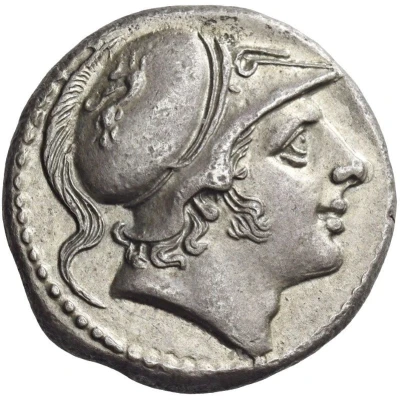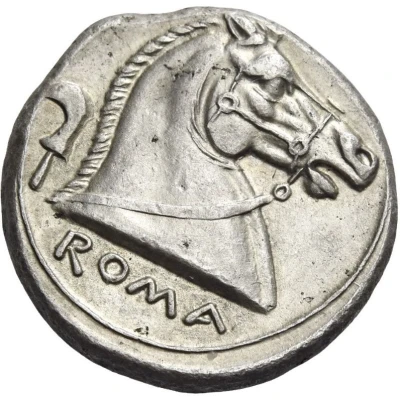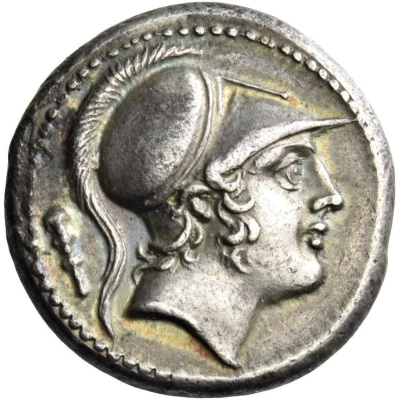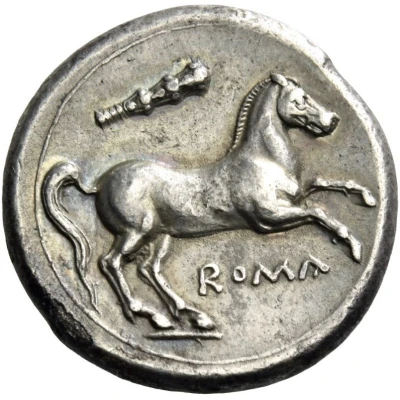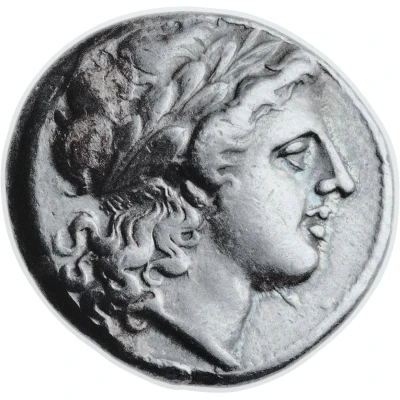
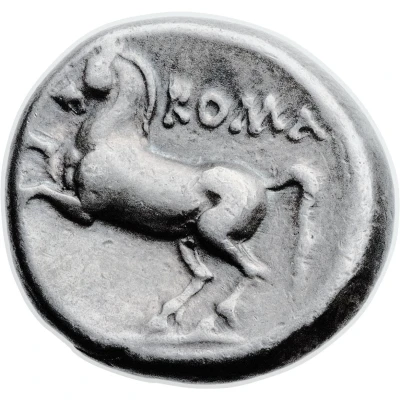

© Heritage Auctions
Didrachm Anonymous; ROMA 234 BC - 231 BC
| Silver | 6.62 g | 19 mm |
| Issuer | Rome › Roman Republic (509 BC - 27 BC) |
|---|---|
| Period | Republic (509 BC - 27 BC) |
| Type | Standard circulation coin |
| Years | 234 BC - 231 BC |
| Value | Didrachm (2) |
| Currency | Drachm (?-235 BC) |
| Composition | Silver |
| Weight | 6.62 g |
| Diameter | 19 mm |
| Shape | Round (irregular) |
| Technique | Hammered |
| Orientation | Variable alignment ↺ |
| Demonetized | Yes |
| Updated | 2024-10-06 |
| Numista | N#67099 |
|---|---|
| Rarity index | 100% |
Reverse
Horse prancing left; above, inscription.
Script: Latin
Lettering: ROMA
Comment
For this type, Crawford found an estimate of nine right-hand corners and twelve reverse corners. Crawford also points out that Bahrfelt found eighteen examples, while Hersch listed eighty, and thirteen didrachms were known from the treasures. The authors of the catalog of the Haeberlin collection (Adolph E. Cahn and Adolph Hess) remarked on the style of this didrachm. This type is one of the rarest Roman coins of Greek origin (Rarity grade R3).One of the earliest Roman coins, it was previously attributed to Capua or Campagnia. Struck on a Roman-Campanian standard, this Greek coinage does not yet feature Roman iconography. The types are Hellenistic. Right and reverse are not far removed from the first Campagnian standard didrachms minted between -280 and -275 at the time of the war against Pyrrhus (RCV. 2). Only the legend on the reverse (ROMA) allows this coinage to be traced back to Rome after the First Punic War. The chronology of this Romano-Campanian didrachm remains controversial. First fixed by H. A. Grueber between -312 and -290-, this type is traditionally dated between -234 and -231. Recently, D. Sear prefers to assign it a broader chronological range, between -235 and -230. In very good style, it predates the start of the Second Punic War and is not found with the Janiform-headed Roman-Campanian quadrigates or didrachms, as M. Crawford points out (RRC. p. 40-41). His demonstration is based on the Catanzaro treasure (IGCH. 2019), discovered in 1967 and containing thirty-six silver coins, buried at the end of the -IIIth century, of mixed composition with species from Southern Italy (Taranto, Heraclius, Bretiens), Carthaginian (half-shekel), accompanied by a Romano-Campagnian didrachm of this type. Alongside the didrachm, this issue also includes a drachma, a litra and a half-litra for silver, with associated bronze aces, semis, quadrans and sextants.
Roman coins, Laurent Schmitt, Michel Prieur.
Interesting fact
The Didrachm coin was used during the Roman Republic, a time when Rome was still a republic and not yet an empire. It's interesting to note that the coin's design features a portrait of a Roman goddess, likely Juno or Venus, on one side, and a mythical creature, possibly a griffin or a sphinx, on the other. This blend of Roman and Greek influences in the coin's design reflects the cultural exchange and blending that occurred during this time period.
Price
| Date | Mintage | VG | F | VF | XF | AU | UNC |
|---|---|---|---|---|---|---|---|
| ND (234 BC - 231 BC) | - | - | - | - | - | - |
Values in the table are based on evaluations by sales realized on Internet platforms. They serve as an indication only for Didrachm (Anonymous; ROMA) (234 BC - 231 BC) coin.
